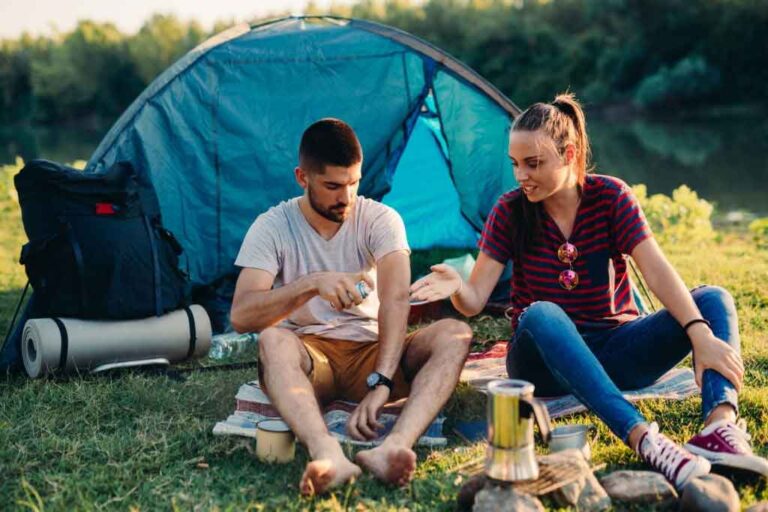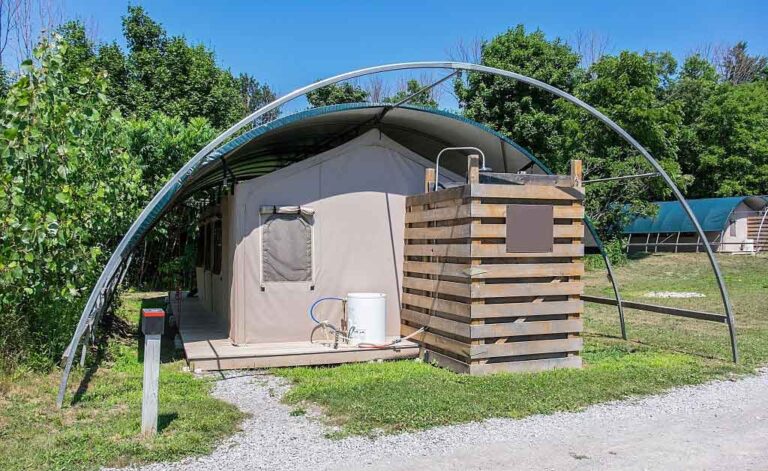How to Keep RV Pipes From Freezing While Camping: A Detailed Guide
When it’s winter around the corner and your inner camper calls for camping, you can’t help but take your RV and go camping. Even if you camp in areas where the temperature is moderate but nights get colder, or you camp at a place of higher altitude where weather is unpredictable.
Your four-wheeler will work fine in summers, but in winters there are many potential threats to your metal shelter. From freezing RV waterlines to ruptured pipes, from pests invading to liquid can leakage. You need a proper guide on how to Keep RV Pipes From Freezing While Camping
Taking precautionary measures is always better than paying the cost of damage. Little investment in your RV before camping will save plenty of nerve-racking ordeals on the camping site.
As I am beginning to describe the steps you need to consider for proper inside, outside insulation of your RV, you need to go over them. Because following these steps will not only make your life easier but will rock your camping experience in the areas where there is a temperature below freezing point. So let’s have a look at them:
How to Keep RV Pipes From Freezing While Camping
When RV will Start Freezing?
First of all, you need to know about the temperature at which your RV might freeze. Facts state that it usually takes 22 – 24 hours at constant below freezing temperature to freeze your RV. However it greatly depends upon the RV type how much cold it withstands, you can take the help of your rig’s owner before winterizing it.
There are some RV’s in which water system and sewage lines are completely located inside the RV body, no pipeline is going undercarriage that will reduce the chances of exposure of pipes to cold. But if it’s otherwise don’t worry you can still enjoy your winter season camping by taking smart measures to survive cold weather and prevent any hitch.
Check your RV’s Power Storage and Batteries
It is very important to make sure your RV’s power storage is pretty enough that will keep the furnace running.
Make sure batteries are fully charged and are given the required service before use, the water level is topped up and electrolytes are good to start. Take extra power along with you if you are going to use a propane heater or a hairdryer.

Make sure you have spare power to utilize in emergency conditions. Always be prepared and armed your RV with power resources.
Seal Off/Caulk the Splits and Rifts of your RV
RV insulation starts with minor splits and window lines which are small openings but could be substantial to cold air entry. If any space is left opened it can become a possible passage of critters.
Of course, you wouldn’t want your food packs ruined by rodents and rats along with constant cold breeze invading and lowering the temperature of your rig. Pressurized nitrogen spray foam or sealants are a great solution to seal the slits.
Cover Vents, Exhaust Pipes, and Vehicle’s Chassis
Your RV’s ventilation system is no doubt great to keep your RV airy and prevent any suffocation. But the fact is, during winters you are trying hard to keep your rig’s inner atmosphere warmer, now suppose if your rig’s vent or exhaust pipes are letting the warm air escape out and cold air come in how would you maintain warmth inside?. Therefore, make sure the vehicle’s openings are properly covered, foamed, and insulated.
RV Skirting
Once the inside is all sealed, it’s time to work on the undercarriage insulation. Skirting is a perfect way to protect your RV’s underbelly. Skirting will cover the underneath area of your rig and hinders the chilly wind’s reach to your floor and water hose because it is the most exposed part to cold.
There are many types of skirting material available like vinyl, plywood, insulation boards. Do the research and get the best-suited materials for your vehicle’s skirting.
Certainly skirting is an effective method to trap the heat inside, keep the floor temperature warm and ultimately increase the efficiency of the thermal furnace. But it has a drawback; just as the sultry weather attracts the swarms of insects, it will attract the critters that are escaping from the cold and are in search of a warmer place. You need to take extra measures to keep critters away.
RV Flooring
The more steps you take to keep your RV warm the more you will be able to get out of your water camping while enjoying live snowfall and the wonders of pearly mountains.
But before everything comes to your health. Along with your RV, you need to keep yourself warm too, by layering yourself with stuff that resists cold and keep your RV’s floor warm by using simple material like rugs and fluffy carpets.
Change the Fluids Before Flight:
Before you embark on your camping journey, check the liquids of your RV. When I say liquids it means any liquid ranging from oil to water. So give your moving home a regular oil change especially before camping, check the stabilizers for the gasoline tank and generator, check the fluid mixture ratio.
Usually, RV’s servicemen know such things better than the owners, but now it’s going to be your tiny home away from home so you too need to know everything about it. Regarding water, we will discuss it in detail.
Emptying the Sewage Tank and Bathroom Tank:

Another crucial fluid is water; whether it’s grey, black or fresh. Keeping it from freezing is a whole hack. First of all black tank draining is necessary because if the sewage water freezes, it will push the whole system backward leading to flooding inside the RV. That is why dealing with sewage water is a very important factor.
After that, you need to clean your grey tank. The wastewater of the sink and shower needs to be drained from time to time, you need to prevent the grey tank to be filled to the top. Otherwise, it can freeze too and as a matter of fact, frozen water expands causing cracks in the tank. And when it melts down, it can leakage into the entire water system.
That is the reason it is advised to keep draining sewage at least to half to make space for expansion in case the freezing happens. Add black tank cleaner or bleach will keep it clean.
Freshwater Tank – How to Keep It Warm:
The freshwater tank is substantial to frost danger. When water is still, it freezes more quickly. The transition phase of water starts at 32 Fahrenheit or O Celsius. When this temperature remains constant or increases for at least 24 hours, water starts slushing before it becomes solid.
It’s hard to move slushy water in the pipes however, you can still move it by blowing compressed air, or with the help of a propane torch, you can quickly heat the metal pipes.
1) Non-Toxic Antifreeze Liquid
Adding antifreeze in water will lower the freezing point of water, protecting the water tank from freezing. It would be a lifesaver for those days when you are camping at high altitudes and temperature is expected to fall below freezing point.
Anti-freeze is a non-toxic and consumable liquid, though it’s not harmful to health it leaves an unusual odour and taste in the freshwater.
2) Half-Empty Your Water Tank
Another measure that you can take is to clean up your fresh water tank at night only if you have a water supply available nearby, it will prevent the water from freezing and causing severe damage to your water system. But make sure to leave few liters of water in the tank. Of course, you wouldn’t want your freshwater storage tank to become a cube of ice.
3) Water Heater
Antifreezing your water tank is nevertheless a good option but attaching a water heater to it would be even better. No one can deny the importance of warm waters when outside is freezing. Having a hot shower in the cold keeps you warm while enjoying the snow outside is a luxury at camping. More so you can easily do dishwashing and other chores when the water is cosy.
A water heater requires a power supply and you can only use it for a limited time, but if there is an outdoor electric supply available at your camping site, that would be the best source of heat for you as it will keep your water tank warm.
Some water tanks usually have a heater system attached to them, but if your water tank doesn’t have one you can employ an electric or propane heater to it.
4) Electric Pad
Another effective method you can use to keep your water tank warm is to cover it with an electric pad. Electric blankets can serve the purpose of electric pads. Even at 12-14 volts, your electric pad will protect your water system from freezing. This might be the best method but this too comes with a limitation – it uses electricity.
Before choosing the best fit trick for your RV, you need to consider the pros and cons of each method.
RV Water Pipes and Hoses:
Water pipes are also at high risk of frosting. To deal with the challenging weather you will be required to put extra effort into protecting your RV’s pipes. First, you need to insulate the water pipes in your RV’s undercarriage if the water pipeline is outside. Insulating the pipes keeps your RV’s water system working and helps to maintain the thermal temperature.
Insulation Wrap and Electrical Tape
Insulating the pipes and hoses with insulation wrap and electric tape provides thermal insulation. It is best for those times when it gets too cold outside and your pipeline is routed through the underbelly of your rig. Pipes with insulation wrapped around them will help prevent their direct contact with the colder air. Whereas, electric tape around them
Heat Cable Kit and Tape
Heat cable kits come with a built-in thermostat, and an automatic system to keep the pipes warm. You can spiral-wrap the tape around any pipe, located outside or inside the RV, and plug the kit’s end into an electric outlet or power outlet. Make sure you wrap it tightly to get the best results.
When the temperature falls below freezing point, heat tape will automatically heat up and keep the pipes warm. Another advantage of having cable kits is that you can leave them plugged in, these kits are operated automatically.
Foam Insulation on the Hoses
Foam insulation can eliminate heat leakage because it acts as an airtight seal. This is why it can keep the pipes from freezing. More so, it can be applied to rood and walls as well. Foam board insulation and spray foam insulation both are good to use. But spray foam insulation can be costly and the process might create a mess around your RV.
Interior water pipes are considered protected from freezing when the temperature outside is not too cold because they are inside the RV. But it doesn’t mean they won’t freeze. When it becomes harsh cold outside, you need to wrap them too to protect them from freezing.
Water valves are also substantial to freezing because they are present outside your RV. They are the connection points and can stop the flow of water if gets frozen. There are so many ways you can keep them from freezing like using a small electric or propane space heater or using a heat lamp to keep them warm and save them from potential damage.
RV’s Water Pump:
No doubt water pump is one of the most vulnerable things to the frosting. When the pump freezes, its connections start malfunctioning. It will directly affect the whole water system and pipes. That is why adding a heater near this area will prevent it from freezing and ultimately will save you from a lot of repair expenses.
Propane Heater Inside and Under your RV:
Portable propane heaters are a good source of heat in freezing temperatures.
You can use them inside your RV to maintain warm and you can place them under your RV’s carriage to trap the heat and keep the pipelines and floor warm. Since they need proper ventilation to exhaust out the gases like monoxides, their long-term usage isn’t good for health if there is no vent available.
In addition, a propane heater requires proper fire safety measures because you cannot place anything on top of it and you can’t move them while it’s on.
An electric space heater can also be used at the place of propane if you want to avoid monoxide. Approx. 250- 500 watt space heater is enough to keep the pipes from freezing.
Keeping your RV’s Fridge Clean:
More often than less, people usually ignore the thorough cleaning of their RV fridge. But keeping your fridges interior, waterlines, and inside of doors clean is equally necessary.

Because if you don’t clean it, there are chances that the residual water might freeze and food might cause odour in your fridge. Make sure before heading towards the journey you give a detailed clean-up to your fridge so that any leftovers and residuals won’t cause any fungus growth or other mess.
How to Protect RV Tires?
Tires are undoubtedly the most important part of your RV, as your home is entirely dependent upon the function of those 4 circulating wheels. Therefore, go through the checklist to ensure better health and safety of your tires.
- Keep the pressure full in them for winter camping to avoid any unforeseen hazards.
- Covering the tires with tire covers can prevent their direct exposure to chilly winds and scorching sun. In short, investing in good tire covers can protect them from harsh atmosphere both in summer and winter.
- To minimize the load on the tires, you can lower your RV’s stabilizer jacks when your RV is standing. It adds to the health of the wheels.

What To Do if Hoses are Frozen?
Despite all the measures and precautions, even if your RV’s hoses freeze you need to think about the solutions: You can use a temporary heat source like a hairdryer, or a heat gun on the frozen hose connections to quickly thaw them. Constantly exposing them to a quick heat source or blowing warm air will help to melt the solid ice or slushy ice.

Make sure you do not disconnect the hose when it has ice in it otherwise you will cause severe damage to it that might lead to flooding. Therefore, keep it warm, wait for the ice to melt, and then disconnect it from the RV ports and form the water supply. Besides this, you should be prepared for any unforeseen situation that can come unplanned.
Winter Camping – Final word
Winter camping can be more exciting because it’s less busy and offers a lot of snow games that you cannot enjoy during summer camping.
But at the same time, winter camping requires a lot more planning and preparation because any unexpected events can happen. But taking all the precautionary measures and planning well beforehand will help you make your adventure trip full of activities because you are not going in the cold just to stay inside and sleep.
You can also have a look at our detailed guide on how to insulate your tent for winter camping.
Thorough research on how to keep yourself warm will add to the whole experience and help keep your RV from freezing. Moreover, you can read our other articles related to camping to make you fully prepared and equipped with all kinds of gear.








One Comment